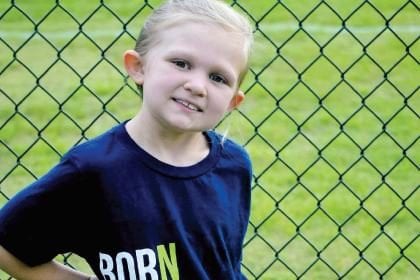
2016 Alabama Walk to End NF
Published: September 30, 2016
By: Paige Townley
For eight-year-old Izzy Camp, the outward signs aren’t very obvious. Upon first glance, most would never know she’s living with neurofibromatosis, an incurable set of genetic disorders that cause tumors to grow in the nervous system. “Physically, there really isn’t anything wrong with her,” says her mother, Julie. “But the signs are there. She recently had an eye exam and it revealed that she has nodules on her eyes. They are small, but it’s a sign of her condition.”
In February 2016, Izzy was officially diagnosed with neurofibromatosis. The only outward sign: dozens of light spots on her skin. “It was an immediate diagnosis,” Julie adds. “We went to the UAB Neurofibromatosis Clinic and no blood test was even needed because she had close to 100 spots on her body.”
Neurofibromatosis is classified into three different types, which are all caused by different genes. NF1 is the most common, affecting one in every 3,000 children. The disorders affect both sexes and all races equally. For 11-year-old Philip Moss, the signs were much more obvious. In 2011, when he was getting ready to start kindergarten, a checkup with his pediatrician revealed a swollen area on his neck. After consulting with the doctor, Philip’s parents made the decision for it to be removed. “We thought it was a lymph node,” says his mother, Renie. “But three weeks after the surgery we got a call that said it was a tumor. And that began our journey.”
While the tumor wasn’t cancerous, it did indicate that Philip suffered from neurofibromatosis (NF1). A few months later, in January 2012, an MRI revealed the tumor had grown back. “We knew it was there because we could see it, and in fact it had grown back to be bigger than it was originally,” Renie says. “It was concerning because it was near his airway.”
While the tumor was causing Philip no pain, the tumor’s growth was outpacing his growth. Because doctors already removed the tumor once, surgery was no longer an option. The family’s only option was to watch and wait, knowing that there was a 10 to 15 percent chance the tumor could become malignant. “We monitored it and hoped it would it would stop growing,” Renie says. “There’s really nothing you can do. We had to learn to live with the anxiety and fears since there was no cure.”
By 2014, the tumor was very large and quite visible. It was also starting to push on his airway. Philip’s doctor at the UAB Neurofibromatosis Clinic said the “wait and see” approach was over. “We had to figure out a game plan, and doctors were even looking at a potential tracheotomy,” Renie says. “But the decision was made to try chemotherapy first.”
Philip was referred to an oncologist at Children’s of Alabama and began oral chemotherapy. He received the treatment for eight weeks, and in April 2015, they found out the treatment was unsuccessful. “I remember walking out of that last appointment and remember being told that if that particular chemo didn’t work, others wouldn’t work either,” Renie adds. “It was heartbreaking to walk out with nothing.”
Philip was waitlisted for an upcoming drug trial through the National Institutes of Health (NIH). The family was waiting to see if he would get one of only 50 slots available for the trial. In August, the family got the call he was in. Two weeks later, they were on a plane to Bethesda, Maryland. By late September Philip began an oral chemotherapy that was being tested for his particular pediatric need. “There were a lot of emotions because he was really sick those first four months and missed a lot of school, we missed a lot of work, but we had lots of prayers and support,” Renie says. “And, thankfully, he seemed to turn the corner.”
After a few months he began to feel better physically, and after eight months on the drug, tests revealed in April 2016 that the tumor shrunk approximately 23 percent. After 12 months on the trial, the tumor had decreased by 36 percent. “It’s dramatic,” Renie says. “You can see such a dramatic difference in his neck. It’s a miracle drug. We feel very fortunate and privileged to be a part of the first group of children to be on this drug. We hope and pray that it will be on the market as soon as possible for all of the other families waiting for it.”
In Birmingham alone, there is a community of families living with neurofibromatosis. For the past two years, they have held the Walk to End NF. The third annual event will be held October 16 at Veterans Park in Hoover.
The goal is to raise $75,000 for research and provide support for individuals with neurofibromatosis and their families. “Last year we exceeded our goal and had the fourth highest neurofibromatosis fundraising walk in the country and highest number of participants,” Renie says. “We hope to beat that this year. And we feel very fortunate that we raise money and know exactly where it’s going. Eighty percent of every dollar raised goes straight to research. We’ll keep doing this walk until there is a cure.”
For more information about neurofibromatosis, visit http://www.ctf.org. For more information about Walk to End NF, visit http://www.nfwalk.org/alabama.
2016 Alabama NF Walk
|
When: |
October 16, 2016 at 1p.m. |
|
Where: |
Veterans Park 4800 Valleydale RoadHoover, AL 35216 |
|
Contact: |
